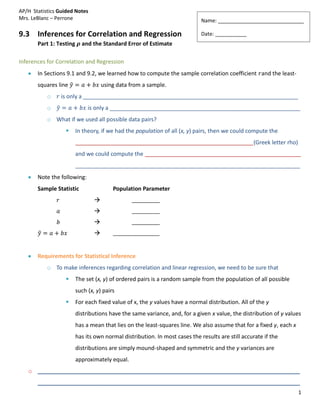
9.1 9.2 9.3 using the graph calc
- 1. AP/H Statistics Guided Notes Mrs. LeBlanc – Perrone Name: ______________________________ 9.3 Inferences for Correlation and Regression Date: ___________ Part 1: Testing and the Standard Error of Estimate Inferences for Correlation and Regression In Sections 9.1 and 9.2, we learned how to compute the sample correlation coefficient and the least- squares line using data from a sample. o is only a _____________________________________________________________________ o is only a _____________________________________________________________ o What if we used all possible data pairs? In theory, if we had the population of all (x, y) pairs, then we could compute the _________________________________________________________(Greek letter rho) and we could compute the __________________________________________________ ________________________________________________________________________ Note the following: Sample Statistic Population Parameter Requirements for Statistical Inference o To make inferences regarding correlation and linear regression, we need to be sure that The set (x, y) of ordered pairs is a random sample from the population of all possible such (x, y) pairs For each fixed value of x, the y values have a normal distribution. All of the y distributions have the same variance, and, for a given x value, the distribution of y values has a mean that lies on the least-squares line. We also assume that for a fixed y, each x has its own normal distribution. In most cases the results are still accurate if the distributions are simply mound-shaped and symmetric and the y variances are approximately equal. o ____________________________________________________________________________________ ____________________________________________________________________________________ 1
- 2. AP/H Statistics Guided Notes Mrs. LeBlanc – Perrone Testing the Correlation Coefficient The first topic we want to study is the statistical significance of the sample correlation coefficient r. To do this, we construct a statistical test of , the population correlation coefficient. How to Test the population correlation coefficient Let be the sample correlation coefficient computed using data pair ( ) 1. Use the null hypothesis (x and y have _______________________________). Use the context of the application to state the alternate hypothesis ( ). State the level of significance . 2. Obtain a sample of data pairs and compute the sample test statistic with degrees of freedom 3. Use the TI-83 or TI-84 to calculate the _____________________ _______________________________________________________________________ 4. Conclude the test If the P-values is , then reject If the P-values is , then fail to reject 5. Interpret the results in the context of your application 2
- 3. AP/H Statistics Guided Notes Mrs. LeBlanc – Perrone Example: Testing Do college graduates have an improved chance at a better income? Is there a trend in the general population to support the “learn more, earn more” statement? We suspect the population correlation is positive, let’s test using a 1% level of significance. Consider the following variables: x = percentage of the population 25 or older with at least four years of college and y = percentage growth in per capita income over the past seven years. A random sample of six communities in Ohio gave the information shown Caution: Although we have shown that x and y are positively correlated, we have not shown that an increase in education causes an increase in earnings. 3
- 4. AP/H Statistics Guided Notes Mrs. LeBlanc – Perrone You Try It! A medical research team is studying the effect of a new drug on red blood cells. Let x be a random variable representing milligrams of the drug given to a patient. Let y be a random variable representing red blood cells per cubic milliliter of whole blood. A random sample of volunteer patients gave the following results. x 9.2 10.1 9.0 12.5 8.8 9.1 9.5 y 5.0 4.8 4.5 5.7 5.1 4.6 4.2 Use a 1% level of significance to test the claim that 4
- 5. AP/H Statistics Guided Notes Mrs. LeBlanc – Perrone Standard Error of Estimate Sometimes a scatter diagram clearly ______________________________________________________ between x and y, but it can happen that the points are widely scattered about the least-squares line. We need a method (besides just looking) for measuring the spread of a set of points about the least- squares line. There are three common methods of measuring the spread. o the coefficient of correlation o the coefficient of determination o ______________________________________________________ For the standard error of estimate, we use a measure of spread that is in some ways like the standard deviation of measurements of a single variable. Let_________________________________ ________________________________________________from the least-squares line. Then y – is the difference between the y value of the data point (x, y) shown on the scatter diagram (Figure 9-16) and the value of the point on the least-squares line with the same x value. The quantity __________ is known as the ___________________. To avoid the difficulty of having some positive and some negative values, we square the quantity (y – ). Then we sum the squares and, for technical reasons, divide this sum by n – 2. Finally, we take the square root to obtain the standard error of estimate, denoted by S . e Standard Error of Estimate = ______________________________________________ where and Using the TI 83 & TI 84 1. STAT 2. TEST 3. LinRegTTest The value for is given as 5
- 6. AP/H Statistics Guided Notes Mrs. LeBlanc – Perrone Example June and Jim are partners in the chemistry lab. Their assignment is to determine how much copper sulfate (CuSO ) will dissolve in water at 10, 20, 30, 40, 50, 60, and 70°C.Their lab results are shown in Table 9-12, 4 where y is the weight in grams of copper sulfatethat will dissolve in 100 grams of water at x°C. Sketch a scatter diagram, find the equation of the least-squares line, and compute 6
- 7. AP/H Statistics Guided Notes Mrs. LeBlanc – Perrone Summary Questions 1. What does testing the population correlation coefficient show? ____________________________________________________________________________________ ____________________________________________________________________________________ ____________________________________________________________________________________ ____________________________________________________________________________________ 2. Complete 9.1 – 9.3 Graphing Calculator Exercises (including the “You Try It”) “HOT” Question: __________________________________________________________________________________________ __________________________________________________________________________________________ 7